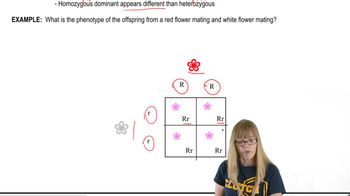Table of contents
- 1. Introduction to Genetics51m
- 2. Mendel's Laws of Inheritance3h 37m
- 3. Extensions to Mendelian Inheritance2h 41m
- 4. Genetic Mapping and Linkage2h 28m
- 5. Genetics of Bacteria and Viruses1h 21m
- 6. Chromosomal Variation1h 48m
- 7. DNA and Chromosome Structure56m
- 8. DNA Replication1h 10m
- 9. Mitosis and Meiosis1h 34m
- 10. Transcription1h 0m
- 11. Translation58m
- 12. Gene Regulation in Prokaryotes1h 19m
- 13. Gene Regulation in Eukaryotes44m
- 14. Genetic Control of Development44m
- 15. Genomes and Genomics1h 50m
- 16. Transposable Elements47m
- 17. Mutation, Repair, and Recombination1h 6m
- 18. Molecular Genetic Tools19m
- 19. Cancer Genetics29m
- 20. Quantitative Genetics1h 26m
- 21. Population Genetics50m
- 22. Evolutionary Genetics29m
2. Mendel's Laws of Inheritance
Probability and Genetics
Problem 18h
Textbook Question
In pea plants, the appearance of flowers along the main stem is a dominant phenotype called 'axial' and is controlled by an allele T. The recessive phenotype, produced by an allele t, has flowers only at the end of the stem and is called 'terminal.' Pod form displays a dominant phenotype, 'inflated,' controlled by an allele C, and a recessive 'constricted' form, produced by the c allele. A cross is made between a pure-breeding axial, constricted plant and a plant that is pure-breeding terminal, inflated.
Suppose that all of the F₂ progeny with terminal flowers, i.e., plants with terminal flowers and inflated pods and plants with terminal flowers and constricted pods, are saved and allowed to self-fertilize to produce a partial F₃ generation. What is the expected phenotypic distribution among these F₃ plants?
 Verified step by step guidance
Verified step by step guidance1
Identify the genotypes of the parent plants. The pure-breeding axial, constricted plant has the genotype TTcc, and the pure-breeding terminal, inflated plant has the genotype ttCC.
Determine the genotype of the F1 generation. Since the F1 generation is a result of crossing TTcc with ttCC, all F1 plants will have the genotype TtCc, displaying the dominant phenotypes: axial flowers and inflated pods.
Consider the F2 generation. When F1 plants (TtCc) are self-fertilized, the F2 generation will have a variety of genotypes due to independent assortment, including ttcc, which will display the terminal flower phenotype.
Focus on the F2 plants with terminal flowers (tt__). These plants can have genotypes ttCC, ttCc, or ttcc. Only these plants are saved and allowed to self-fertilize to produce the F3 generation.
Predict the phenotypic distribution in the F3 generation. Since the F3 generation comes from self-fertilizing F2 plants with terminal flowers, consider the possible combinations of alleles for pod form (C and c) to determine the phenotypic ratios of terminal flowers with inflated and constricted pods.
Recommended similar problem, with video answer:
 Verified Solution
Verified SolutionThis video solution was recommended by our tutors as helpful for the problem above
Video duration:
4mPlay a video:
Was this helpful?
Key Concepts
Here are the essential concepts you must grasp in order to answer the question correctly.
Dominant and Recessive Alleles
In genetics, alleles are different forms of a gene that can exist at a specific locus on a chromosome. Dominant alleles, represented by uppercase letters (e.g., T, C), mask the expression of recessive alleles (e.g., t, c) when both are present. This means that the phenotype associated with the dominant allele will be expressed in the organism, while the recessive phenotype will only appear when two recessive alleles are present.
Recommended video:
Guided course

Variations on Dominance
Punnett Square and Genetic Crosses
A Punnett square is a diagram used to predict the genotypes and phenotypes of offspring from a genetic cross. By organizing the alleles from each parent, it allows for the visualization of potential combinations in the offspring. In this scenario, understanding how to set up a Punnett square for the axial and terminal flower traits, as well as the inflated and constricted pod traits, is essential for predicting the phenotypic ratios in the F₃ generation.
Recommended video:
Guided course

Punnet Square
Self-Fertilization and Generational Analysis
Self-fertilization occurs when a plant's pollen fertilizes its own ovules, leading to the production of offspring that may exhibit a variety of phenotypes based on the genetic makeup of the parent. In this case, analyzing the F₂ progeny that are allowed to self-fertilize helps determine the expected phenotypic distribution in the F₃ generation. Understanding the inheritance patterns and ratios from the F₂ generation is crucial for predicting the outcomes in the F₃ generation.
Recommended video:
Guided course

Chi Square Analysis
Related Videos
Related Practice




